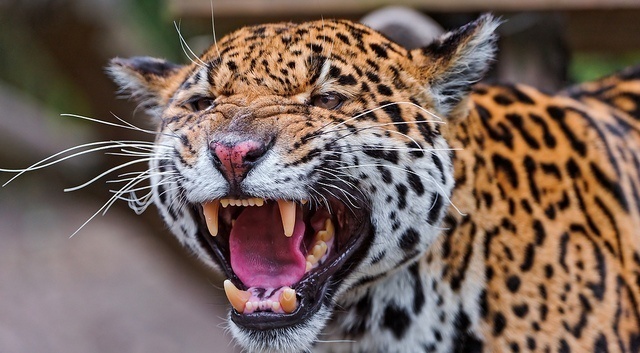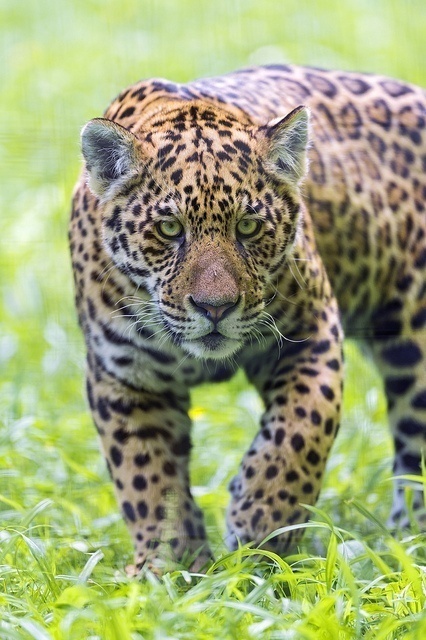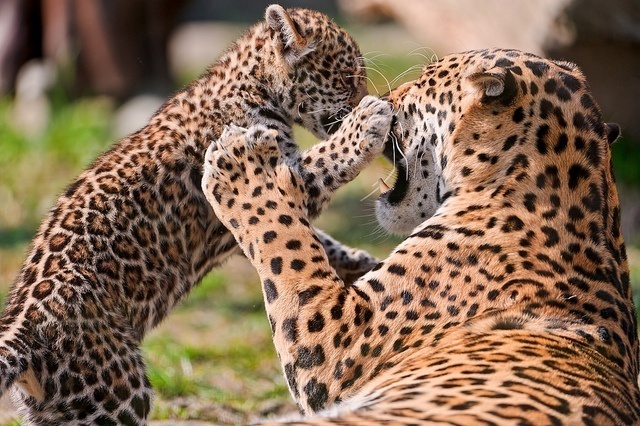Jaguar Attacks Crocodile Video
A-Z Collection of Cool Animals Challenge
J is for Jaguar Attacks Crocodile Video
Check out this video of a jaguar taking down a caiman in Brazil’s Pantanal wetlands. This exclusive National Geographic video is narrated by Luke Dollar, a conservation scientist who helps manage National Geographic’s Big Cats Initiative.
Jaguar Attacks Crocodile Video
Some Interesting Facts About Jaguars
- Jaguars are the third-largest feline after the tiger and the lion. Jaguars normally weight in the range of 124 to 211 lb (56 to 96 kg). Larger males have been recorded to weigh as much as 348 lb (158 kg). Females are typically 10–20% smaller than males.
- The length of the jaguar, from the nose to the base of the tail, ranges from 3.7 to 6.1 ft (1.12 to 1.85 m). Their tails are the shortest of any big cat, at 18 to 30 in (45 to 75 cm) in length.

- They are found only in remote regions of South and Central America—particularly in the Amazon Basin. Dense rainforest is its preferred habitat, but can also be found across a variety of forested and open terrains.
- Unlike many other cats, Jaguars (along with tigers) do not avoid water and they are good swimmers. In rivers, they prey on fish, turtles, and caimans. On land, jaguars hunt larger animals such as deer, peccaries, capybaras, and tapirs, sometimes climbing trees to stalk and ambush their prey.
- Jaguars have the third highest bite force of all felids, after lion and tiger, and can kill their prey with one bite. They kill by biting directly into the skull of prey between the ears to deliver a fast and fatal bite to the brain. They can also pierce the shells of armored reptiles.
- The jaguar hunts wild animals weighing up to 660 lb (300 kg) in dense jungle. An individual jaguar can drag an 800 lb (360 kg) bull 25 ft (7.6 m) in its jaws and pulverize the heaviest bones.
RELATED:
Rare Pallas Cat Facts, Beautifully Wild Feline, aka Manul

- Most jaguars are tan or orange with distinctive black spots, dubbed “rosettes ” for camouflage in the dappled light of its forest habitat. Some Jaguars are so dark, however, that they appear to have no spots.
- Jaguars are solitary animals and are territorial of many square miles, marking their territories with their waste or by clawing trees.
- Females have litters of one to four cubs. The cubs are blind and helpless at birth and gain sight after two weeks. They are weaned at three months but stay in the birth den for six months before leaving to accompany their mother on hunts. The mother defends fiercely from predators – and even their own father.
- Young Jaguars learn to hunt by living with their mothers for one to two years before leaving to establish their own territory.

- The typical lifespan for a jaguar in the wild is thought to be around 12–15 years. The Jaguar has been known to live up to 23 years in captivity.
- Jaguars are considered a near threatened species and its numbers are declining. Threats include loss of habitat. and they are still hunted by humans for their fur. Jaguars are also killed by ranchers because they prey upon their livestock.
Photo Credits: Tambako The Jaguar
J is for Jaguar Attacks Crocodile Video : A-Z of Cool Animals #AtoZChallenge @AprilA2Z #wildlife Share on X
![]()
**A-Z Collection of Cool Animals April Challenge: MASTER LIST**
A QUESTION FOR YOU:
Did you enjoy today’s “Jaguar Attacks Crocodile Video”?
*** Leave your comment below. ***
(It’s just sexy!)

Thank you for visiting my blog today!

Peace
DISCLOSURE: Animal Bliss is a participant in the Amazon Services LLC Associates Program, an affiliate advertising program designed to provide a means for us to earn fees by linking to Amazon.com and affiliated sites.
(In other words, we’ll get a very small (teeny tiny) commission from purchases made through links on this website.)
So, go on … Don’t be shy!
Buy Something BIG and Expensive!
Thank you!
😀
[amazon_link asins=’1472912195,1581960522,152393574X,1539669068,0486256383,1537313355,0486270130′ template=’ProductCarousel’ store=’animblis-20′ marketplace=’US’ link_id=’6da02495-f3f8-11e7-b139-e1283c2283b5′]
😀
- Mindful Travel With Your Dog This Holiday Season - December 23, 2019
- A-Z of Australia’s Endangered Wildlife - December 20, 2019
- Teaching Your Kids How to Walk the Dog Safely - December 2, 2019


I love jaguars thay area beautiful animal
Yes, they sure are, Sara. Thank you for visiting today!
I love all big cats. I watch Nat Geo Wild all the time. These big cats are so amazing and agile for being so big. My fave has always been the Tigers. Im glad I came to visit your blog 🙂
I’m glad you came to visit my blog too, Sue! I hope it won’t be your last time either. 🙂 I love all cats too, big or small. They’re quite fascinating to me. Take care, and do visit again.
This is an awesome post. I love big cats and this is awesome seeing a leopard take down a caiman. Thanks for sharing. 🙂
You’re welcome, Maria. Thank you for taking the time to visit my blog! 🙂
I absolutely LOVE Big cats! Thanks for sharing this great information on them, I love learning about nature and animals… loved your blog 🙂 Thank you
Oh, thank you, Rachel. I’m glad you enjoyed your visit here! I do hope you’ll come back again soon. Take care. 🙂
What a spectacularly gorgeous animal! They’re so graceful when they stalk. Poachers make me sick to my stomach. I just hope their bad karma comes back to haunt them…
Michele at Angels Bark
Mey, Michele. I’m glad you stopped by and that you enjoy the beauty of the jaguar. They are rather majestic, aren’t they? I’m pretty sure the poachers will get payback, one way or another. Karma never misses. You have an interesting selection picked for your “J” letter! I don’t see Joni Mitchell, one of my personal favorites. I’ll go check out your blog now. Thanks for stopping by! 🙂
Wow! Look at those sharp teeth! And I never knew they could live up to 23 years. They’re such beautiful creatures, especially if enjoyed from afar.
Aren’t they beautiful cats? I’m glad you enjoyed the post (from afar). lol Thanks so much for visiting my blog today. Come back soon!
Jaguars are just gorgeous creatures… and geez scary if caught out in the woods with one. And I really hate poachers and anyone who hurts any animals.
I dislike poachers too. Grr. Yes, the jaguars are gorgeous, aren’t they? Regal. Thanks for your visit and taking the time to read my post, TF. All the best! 🙂